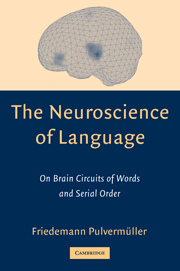Book contents
- Frontmatter
- Contents
- Preface
- The Neuroscience of Language
- 1 A Guide to the Book
- 2 Neuronal Structure and Function
- 3 From Classic Aphasia Research to Modern Neuroimaging
- 4 Words in the Brain
- Excursus E1 Explaining Neuropsychological Double Dissociations
- 5 Regulation, Overlap, and Web Tails
- 6 Neural Algorithms and Neural Networks
- 7 Basic Syntax
- 8 Synfire Chains as the Basis of Serial Order in the Brain
- 9 Sequence Detectors
- 10 Neuronal Grammar
- 11 Neuronal Grammar and Algorithms
- Excursus E2 Basic Bits of Neuronal Grammar
- Excursus E3 A Web Response to a Sentence
- 12 Refining Neuronal Grammar
- Excursus E4 Multiple Reverberation for Resolving Lexical Ambiguity
- Excursus E5 Multiple Reverberations and Multiple Center Embeddings
- 13 Neurophysiology of Syntax
- 14 Linguistics and the Brain
- References
- Abbreviations
- Author Index
- Subject Index
Excursus E4 - Multiple Reverberation for Resolving Lexical Ambiguity
Published online by Cambridge University Press: 15 December 2009
- Frontmatter
- Contents
- Preface
- The Neuroscience of Language
- 1 A Guide to the Book
- 2 Neuronal Structure and Function
- 3 From Classic Aphasia Research to Modern Neuroimaging
- 4 Words in the Brain
- Excursus E1 Explaining Neuropsychological Double Dissociations
- 5 Regulation, Overlap, and Web Tails
- 6 Neural Algorithms and Neural Networks
- 7 Basic Syntax
- 8 Synfire Chains as the Basis of Serial Order in the Brain
- 9 Sequence Detectors
- 10 Neuronal Grammar
- 11 Neuronal Grammar and Algorithms
- Excursus E2 Basic Bits of Neuronal Grammar
- Excursus E3 A Web Response to a Sentence
- 12 Refining Neuronal Grammar
- Excursus E4 Multiple Reverberation for Resolving Lexical Ambiguity
- Excursus E5 Multiple Reverberations and Multiple Center Embeddings
- 13 Neurophysiology of Syntax
- 14 Linguistics and the Brain
- References
- Abbreviations
- Author Index
- Subject Index
Summary
This excursus illustrates circuits motivated by the proposals discussed in Chapter 12. The abbreviations used here and the representation of activity dynamics in table form are the same as those used in Excursuses E2 and E3.
With the extensions of the grammar circuits proposed in Chapter 12, it now becomes possible to treat sentences in which the same word occurs twice and as member of different lexical categories, such as sentence (1).
(1) Betty switches the switch on.
In Chapter 10, Figures 10.3 and 10.4 are used to sketch a putative neuronal correlate of the syntactic category representations that may be connected to the representation of the word form switch. Two of the lexical categories, transitive particle verb, here abbreviated as V, and accusative noun, here abbreviated as N, are relevant for the processing of the syntactically ambiguous word used in sentence (1). The homophonous words and their lexical categories are characterized by the assignment formulas (2) and (3) and the valence formulas (4) and (5).
(2) switch ↔ V (transitive particle verb)
(3) switch ↔ N (accusative noun)
(4) V (p /*/ f1, f2, f3)
(5) N (p1, p2 /*/)
Figure E4.1 shows the entire network used for sentence processing. The representation of the ambiguous word form is doubled for ease of illustration. This figure is almost identical to Figure E3.1, which dealt with a similar sentence. Table E4.1 presents activity dynamics of the sets involved in processing the ambiguous word and its two lexical categories.
- Type
- Chapter
- Information
- The Neuroscience of LanguageOn Brain Circuits of Words and Serial Order, pp. 250 - 254Publisher: Cambridge University PressPrint publication year: 2003



